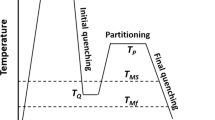Conclusions
-
1.
We investigated the structural changes through the section of 40KhSNA steel tubes after low temperature themomechanical treatment including rolling with balls.
-
2.
This treatment induces irregular deformation and, as a consequence, the changes in structure through the section are irregular. The deformation is irregular during cold and warm working of austenite in Kh18N9T steel during deformation of tubes under these conditions.
-
3.
The irregular deformation results in the fact that the outer layer of metal 0.15–0.2 mm below the surface of the tube undergoes the maximum plastic deformation and consequently the maximum strengthening of the steel in the austenitic state and the formation of a deformation texture. The strength and the texture decrease in deeper layers (0.3–0.4 mm).
-
4.
The irregular flow of metal over the cross section induces elastic zonal stresses (first-order stresses) which reach 35–45 kg/mm2.
-
5.
Irregular deformation of 40KhSNA steel in the austenitic state at subcritical temperatures (550°C) leads to improvement of the austenite in the outer layer in carbon and the precipitation of carbides during deformation and, correspondingly, to the impoverishment of martensite in carbon after quenching. As the result, this layer has the greatest strength when the steel is in the austenitic state and the lowest strength after quenching to martensite.
-
6.
The structural heterogeneity through the section (with the exception of heterogeneity in the texture) can be partly reduced by secondary rapid heating followed by quenching. At the same time, the texture is preserved and this is an indirect proof of the structural correspondence between the lattices of the initial and the new phase occurring not only as the result of the γ→α transformation during quenching but also as the result of the α→γ transformation during rapid heating.
Similar content being viewed by others
Literature Cited
A. P. Gulyaev and A. S. Shigarev, MiTOM, No. 4 (1963).
E. Davenport, TASM, No. 3 (1939).
S. S. Gorelik, Yu. M. Vainblat, and É. A. Malysheva, MiTOM, No. 1 (1962).
S. S. Gorelik, Ya. I. Spektor, É. N. Spektor, FMM,17, No. 3 (1964).
Author information
Authors and Affiliations
Additional information
Translated from Metallovedenie i Termicheskaya Obrabotka Metallov, No. 8, pp. 29–33, August, 1964
Rights and permissions
About this article
Cite this article
Gorelik, S.S., Spektor, Y.I., Spektor, É.N. et al. Structural heterogeneity of steel tubes after thermomechanical treatment. Met Sci Heat Treat 6, 497–501 (1964). https://doi.org/10.1007/BF00652146
Issue Date:
DOI: https://doi.org/10.1007/BF00652146




